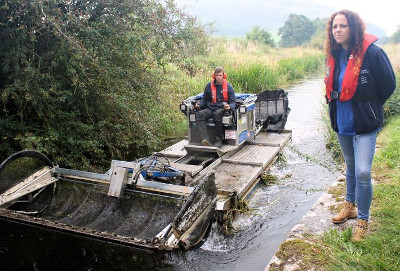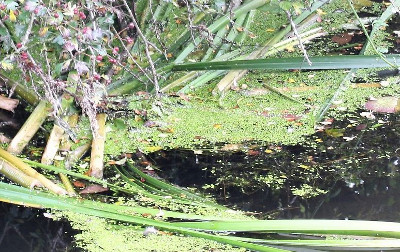AT PRESENT, war is being raged against the culmination of various weeds taking over the Lancaster Canal.
Throughout the summer and early autumn, a combination of warm weather, sunshine and extra nitrates from agricultural run-off create perfect growing conditions for duckweed, water fern, common reeds and Canadian waterweed.
 Thick green carpet
Thick green carpet
These fast-growing plants are spread by passing boats, canoeists, paddle boarders, anglers’ nets and walkers’ muddy boots and, left undisturbed, can form a thick green carpet on the water. This can then cause problems for boat engines, and its solid appearance makes it a potential danger for children and animals.
The hotspots for the weeds are low flow areas around Lancaster, Garstang, Cabus Nook, north Preston, Radcliffe Wharf and Woodplumpton.
Canal & River Trust has stepped up its response on the Lancaster Canal with a massive vegetation clearance programme, including the use of a Truxor amphibious tractor, which this year has scooped up hundreds of tonnes of problematic and invasive weeds from the waterway.
The photograph above shows Canal & River Trust’s Lancaster Canal Operations Manager Angela Parkinson Green assessing the invasive weeds with James Ormrod is at the controls of a Truxor amphibious tractor, which each year clears away hundreds of tonnes of unwanted weeds and reeds from the waterway.
The photograph below shows a close-up of reeds and duckweed.
The water supply for the Lancaster Canal feeds through via the unnavigable Northern Reaches link from Killington Reservoir, near Kendal, and keeping that channel flowing freely is also a constant challenge.
 Severed in three places
Severed in three places
Angela Parkinson Green, Local Area Operations Manager for the trust, explained:
“Since 1968, the canal has only been navigable from Tewitfield southwards after it was severed in three places by the construction of the M6 motorway. This gives us unique challenges on the Lancaster—including the loss of nearly two thirds of the water supply between Killington and Tewitfield. As well as weed and silt removal, every day our staff have to clear out the three M6 culverts which carry the canal water supply under the motorway.
“Weed carpets form easily in low flow areas further south, so it is a constant battle to keep the water flowing and the vegetation away from the canal. It would be great if we could just turn a tap on—but it is a lot more complicated than that.
“The beautiful Lancaster Canal is home to more than 2,500 boats and about 60 per cent are cruisers or have on-board engines which can be damaged by weeds. Traditional narrowboats cope much better with these conditions.
“We have a plan to dramatically reduce the amount of weed in the canal and we are very grateful to the volunteers who have joined with our staff to keep the canal looking its best."
At Tewitfield, Blossom hire boat company has recently adopted a one and half mile stretch of the canal and is making a big difference for the canal users in that area.
